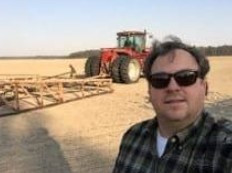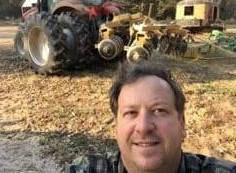By Brad Doyle
All of our rice has been planted. But cool temperatures and a pattern of frequent rain has slowed soybean planting in our area of Arkansas, in the south-central U.S. We started spring field work earlier than average, but due to weather that allows us only 2 or 3 days to work in the field at a time, now our soybeans will be planted later than average.

However, we’ve been working hard to prepare fields for planting. Like any part of the U.S., the way we manage soil and water sustainably is tailored to our soil type and terrain. Our deep, thick layer of clay soil does not allow any water to move through it to drain. The lack of internal soil drainage is ideal for rice production and for efficiently managing irrigation later in the season. But it does require spring field management to effectively grow soybeans.

We rely on a few passes with tillage equipment to create a clean, flat seedbed to plant into. First, disking controls weeds and volunteer soybeans allows us to cut down on herbicide use early in the season. Eliminating volunteer soybeans that sprout from seeds unintentionally left in the field at harvest last year helps ensure the quality of our crop at the end of the season. Herbicides don’t control volunteer soybeans. But because we raise soybeans for seed, including food-grade soybeans, it is important to prevent contamination from weed seeds or soybeans of a different variety. And though we designate some fields for non-GMO soybeans and other fields for GMO soybeans year after year, mechanical weed control further limits potential contamination.
Disking also breaks up ruts left in the field from last harvest. Our heavy clay soils mean we often create ruts in the fall, and we need to work up that ground so crops will grow the following year. After disking, a cultivator further smooths and breaks up the soil to ensure good seed to soil contact both for germination and for effectiveness of the pre-emergence herbicides we apply to control weeds after planting.
Finally, our landplane makes our fields completely flat, to allow good surface drainage of water. And, we can add furrows between the rows to better allow water to drain.
Because our heavy clay soils don’t allow water to move through them, tile drainage systems used in other parts of the U.S. don’t work here. We have to rely on surface drainage. Flat fields and irrigation furrows allow excess water to drain with minimal soil loss in times like this spring, when it is raining often. In fact, once we get furrows in our fields, they dry out more quickly after rains, allowing us to plant sooner. However, later in the summer, when we usually have very dry weather, the same furrows will allow us to efficiently irrigate our soybeans.
Click here to see more...